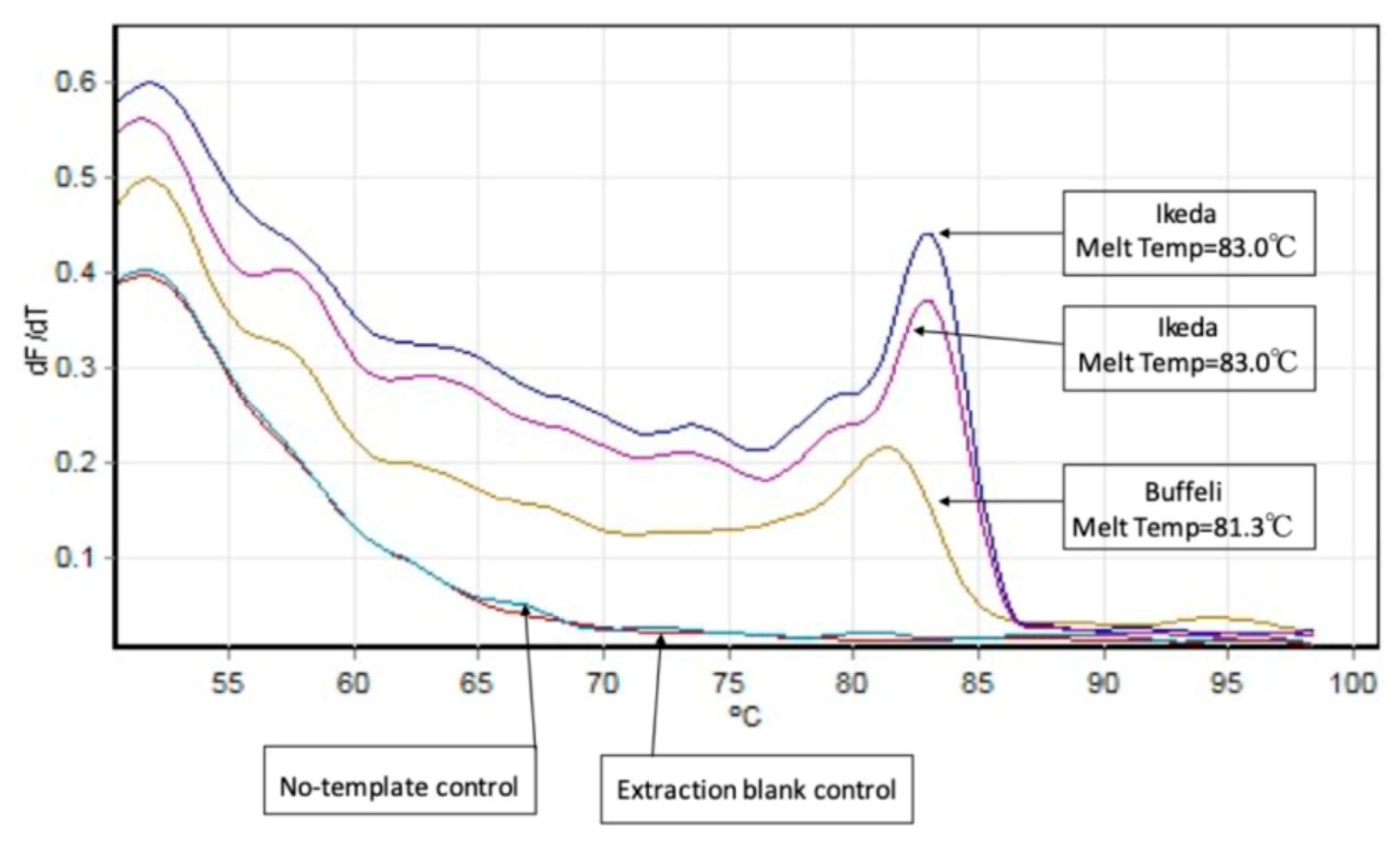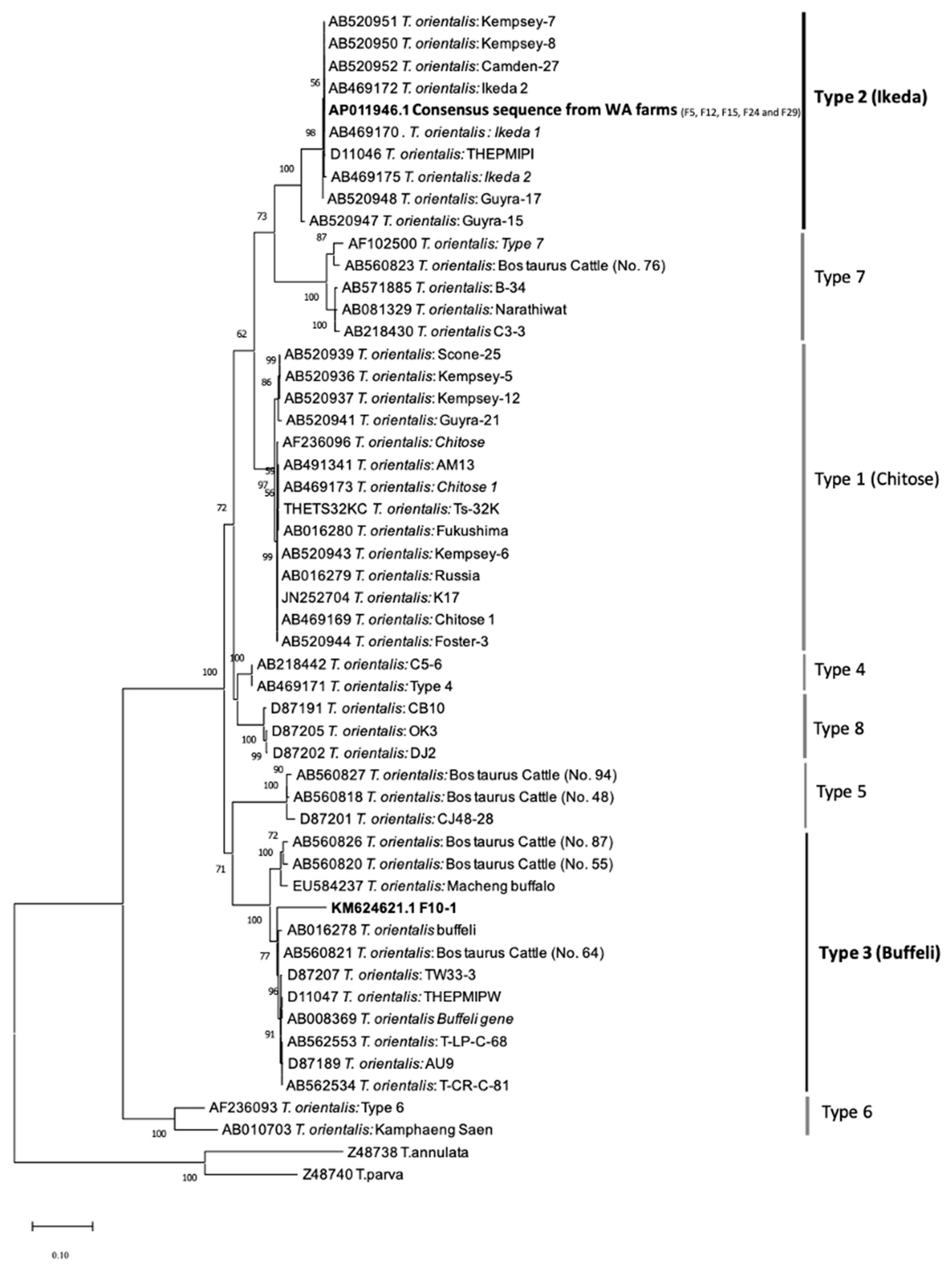Distribution and Prevalence of Theileria orientalis Genotypes in Adult Lactating Dairy Cows in South West Region of Western Australia
Abstract
1. Introduction
2. Materials and Methods
2.1. Ethics Approval
2.2. Study Area
2.3. Study Design and General Data Collection
2.4. Study Populations and Study Farms
2.5. Sample Size Estimations and Selection of Study Subjects
2.6. DNA Extraction and Polymerase Chain Reaction Assays (PCR)
2.7. DNA Purification and Sanger Sequencing
2.8. Genotype Identification and Phylogenetic Analysis
3. Results
3.1. Prevalence and Distribution of Theileria orientalis
3.2. Prevalence of Theileria orientalis Genotypes
3.3. Phylogenetic Analysis
4. Discussion
5. Conclusions
Author Contributions
Funding
Institutional Review Board Statement
Informed Consent Statement
Acknowledgments
Conflicts of Interest
References
- Kamau, J.; de Vos, A.J.; Playford, M.; Salim, B.; Kinyanjui, P.; Sugimoto, C. Emergence of new types of Theileria orientalis in Australian cattle and possible cause of theileriosis outbreaks. Parasites Vectors 2011, 4, 22. [Google Scholar] [CrossRef] [PubMed]
- Marendy, D.; Baker, K.; Emery, D.; Rolls, P.; Stutchbury, R. Haemaphysalis longicornis: The life-cycle on dogs and cattle, with confirmation of its vector status for Theileria orientalis in Australia. Vet. Parasitol. 2020, 277, 100022. [Google Scholar] [CrossRef] [PubMed]
- McFadden, A.; Rawdon, T.; Meyer, J.; Makin, J.; Morley, C.; Clough, R.; Tham, K.; Mullner, P.; Geysen, D. An outbreak of haemolytic anaemia associated with infection of Theileria orientalis in naive cattle. N. Z. Vet. J. 2011, 59, 79–85. [Google Scholar] [CrossRef] [PubMed]
- Forshaw, D.; Alex, S.; Palmer, D.; Cotter, J.; Roberts, W.; Jenkins, C.; Hair, S. Theileria orientalis Ikeda genotype infection associated with anaemia, abortion and death in beef cattle in Western Australia. Aust. Vet. J. 2020, 98, 290–297. [Google Scholar] [CrossRef]
- Dinkel, K.D.; Herndon, D.R.; Noh, S.M.; Lahmers, K.K.; Todd, S.M.; Ueti, M.W.; Scoles, G.A.; Mason, K.L.; Fry, L.M. A US isolate of Theileria orientalis, Ikeda genotype, is transmitted to cattle by the invasive Asian longhorned tick, Haemaphysalis longicornis. Parasites Vectors 2021, 14, 157. [Google Scholar] [CrossRef]
- Jenkins, C.; Micallef, M.; Alex, S.; Collins, D.; Djordjevic, S.; Bogema, D. Temporal dynamics and subpopulation analysis of Theileria orientalis genotypes in cattle. Infect. Genet. Evol. 2015, 32, 199–207. [Google Scholar] [CrossRef]
- Gebrekidan, H.; Gasser, R.B.; Perera, P.K.; McGrath, S.; McGrath, S.; Jabbar, A. Investigating the first outbreak of oriental theileriosis in cattle in South Australia using multiplexed tandem PCR (MT-PCR). Ticks Tick Borne Dis. 2015, 6, 574–578. [Google Scholar] [CrossRef]
- Jenkins, C. Bovine Theileriosis in Australia: A decade of disease. Microbiol. Aust. 2018, 39, 215–219. [Google Scholar] [CrossRef]
- Eamens, G.; Bailey, G.; Gonsalves, J.; Jenkins, C. Distribution and temporal prevalence of Theileria orientalis major piroplasm surface protein types in eastern Australian cattle herds. Aust. Vet. J. 2013, 91, 332–340. [Google Scholar] [CrossRef]
- Bogema, D.; Deutscher, A.; Fell, S.; Collins, D.; Eamens, G.; Jenkins, C. Development and validation of a quantitative PCR assay using multiplexed hydrolysis probes for detection and quantification of Theileria orientalis isolates and differentiation of clinically relevant subtypes. J. Clin. Microbiol. 2015, 53, 941–950. [Google Scholar] [CrossRef]
- Perera, P.K.; Gasser, R.B.; Firestone, S.M.; Anderson, G.A.; Malmo, J.; Davis, G.; Beggs, D.S.; Jabbar, A. Oriental theileriosis in dairy cows causes a significant milk production loss. Parasites Vectors 2014, 7, 73. [Google Scholar] [CrossRef] [PubMed]
- Forshaw, D.; Cotter, J.; Palmer, D.; Roberts, D. Define the Geographical Distribution of Theileria orientalis in the Denmark Shire, 2015. DPIRD. Cattle Industry Funding Scheme Final Report. Available online: https://www.agric.wa.gov.au/sites/gateway/files/Theileria%20orientalis%20-%20Final%20Report.pdf (accessed on 30 September 2021).
- Namgyal, J.; Couloigner, I.; Lysyk, T.J.; Dergousoff, S.J.; Cork, S.C. Comparison of Habitat Suitability Models for Haemaphysalis longicornis Neumann in North America to Determine Its Potential Geographic Range. Int. J. Environ. Res. Public Health 2020, 17, 8285. [Google Scholar] [CrossRef] [PubMed]
- Aleri, J.W.; Sahibzada, S.; Harb, A.; Fisher, A.D.; Waichigo, F.K.; Lee, T.; Robertson, I.D.; Abraham, S. Molecular epidemiology and antimicrobial resistance profiles of Salmonella isolates from dairy heifer calves and adult lactating cows in a Mediterranean pasture-based system of Australia. J. Dairy Sci. 2021, 105, 1493–1503. [Google Scholar] [CrossRef] [PubMed]
- Sergeant, ESG. Epitools Epidemiological Calculators. Available online: http://epitools.ausvet.com.au (accessed on 11 April 2021).
- Taylor, P.G. Reproducibility of Ancient DNA Sequences from Extinct Pleistocene Fauna. Mol. Biol. Evol. 1996, 13, 283–285. [Google Scholar] [CrossRef] [PubMed]
- Greay, T.L.; Zahedi, A.; Krige, A.S.; Owens, J.M.; Rees, R.L.; Ryan, U.M.; Oskam, C.L.; Irwin, P.J. Endemic, exotic and novel apicomplexan parasites detected during a national study of ticks from companion animals in Australia. Parasites Vectors 2018, 11, 197. [Google Scholar] [CrossRef]
- Kawazu, S.; Sugimoto, C.; Kamio, T.; Fujisaki, K. Analysis of the genes encoding immunodominant piroplasm surface proteins of Theileria sergenti and Theileria buffeli by nucleotide sequencing and polymerase chain reaction. Mol. Biochem. Parasitol. 1992, 56, 169–175. [Google Scholar] [CrossRef]
- Yang, B.; Wang, Y.; Qian, P.Y. Sensitivity and correlation of hypervariable regions in 16S rRNA genes in phylogenetic analysis. BMC Bioinform. 2016, 17, 135. [Google Scholar] [CrossRef]
- Kearse, M.; Moir, R.; Wilson, A.; Stones-Havas, S.; Cheung, M.; Sturrock, S.; Buxton, S.; Cooper, A.; Markowitz, S.; Duran, C.; et al. Geneious Basic: An integrated and extendable desktop software platform for the organization and analysis of sequence data. Bioinformatics 2012, 28, 1647–1649. [Google Scholar] [CrossRef]
- Katoh, K.; Misawa, K.; Kuma, K.i.; Miyata, T. MAFFT: A novel method for rapid multiple sequence alignment based on fast Fourier transform. Nucleic Acids Res. 2002, 30, 3059–3066. [Google Scholar] [CrossRef]
- Tamura, K.; Stecher, G.; Kumar, S. MEGA11: Molecular evolutionary genetics analysis version 11. Mol. Biol. Evol. 2021, 38, 3022–3027. [Google Scholar] [CrossRef]
- Meat & Livestock Australia. Available online: https://www.mla.com.au/research-and-development/animal-health-welfare-and-biosecurity/parasites/identification/ticks/ (accessed on 1 October 2021).
- Hammer, J.F.; Emery, D.; Bogema, D.R.; Jenkins, C. Detection of Theileria orientalis genotypes in Haemaphysalis longicornis ticks from southern Australia. Parasites Vectors 2015, 8, 229. [Google Scholar] [CrossRef] [PubMed]
- Hammer, J.F.; Jenkins, C.; Bogema, D.; Emery, D.L. Mechanical transfer of Theileria orientalis: Possible roles of biting arthropods, colostrum and husbandry practices in disease transmission. Parasites Vectors 2016, 9, 34. [Google Scholar] [CrossRef] [PubMed]
- Emery, D.L. Approaches to Integrated Parasite Management (IPM) for Theileria orientalis with an Emphasis on Immunity. Pathogens 2021, 10, 1153. [Google Scholar] [CrossRef] [PubMed]
- Lakew, B.T.; Kheravii, S.K.; Wu, S.-B.; Eastwood, S.; Andrew, N.R.; Jenkins, C.; Walkden-Brown, S.W. Endemic infection of cattle with multiple genotypes of Theileria orientalis on the Northern Tablelands of New South Wales despite limited presence of ticks. Ticks Tick Borne Dis. 2021, 12, 101645. [Google Scholar] [CrossRef] [PubMed]
- Han, Y.J.; Han, D.G.; Chae, J.S.; Park, J.H.; Kim, H.C.; Choi, K.S. Theileria buffeli infections in grazing cattle in the Republic of Korea. Trop. Biomed. 2017, 34, 263–269. [Google Scholar]
- Cufos, N.; Jabbar, A.; de Carvalho, L.M.; Gasser, R.B. Mutation scanning-based analysis of Theileria orientalis populations in cattle following an outbreak. Electrophoresis 2012, 33, 2036–2040. [Google Scholar] [CrossRef]



| Gene | Target | Primer | Sequence (5′–3′) | Size (bp) | Reference |
|---|---|---|---|---|---|
| 16S | Mitochondrial DNA | 16Smam1 16Smam2 | GGTTGGGGTGACCTCGGA CTGTTATCCCTAGGGTAACT | ~140 | [16] |
| 18S | Piroplasms | 18SApiF 18SApiR | ACGAACGAGACCTTAACCTGCTA GGATCACTCGATCGGTAGGAG | ~300 | [17] |
| MPSP (short) | Theileria orientalis spp. | MPSP_F MPSP_R | TGCTATGTTGTCCAAGAGAACG TGTGAGACTCAATGCGCCTAGA | ~300 | [10] |
| MPSP (long) | Theileria orientalis spp. | MPSP_F_Mod MPSP_R | GCAAACAAGGATTTGCACGC TGTGAGACTCAATGCGCCTAGA | ~847 | Modified from [10,18] |
| Farm | MPSP qPCR (Short) | MPSP cPCR (Long) | |||
|---|---|---|---|---|---|
| Number of Animals Positive for T. orientalis (Prevalence %) | 95% CI | Number of Animals Positive for T. orientalis (Prevalence %) | 95% CI | Genotype(s) | |
| 5 | 1 (10%) | 0.3–44.5% | 1 (10%) | 0.3–44.5% | Ikeda |
| 10 | 1 (10%) | 0.3–44.5% | 1 (10%) | 0.3–44.5% | Buffeli |
| 12 | 4 (40%) | 12.2–73.8% | 3 (30%) | 6.7–65.2% | Ikeda |
| 15 | 2 (20%) | 2.5–55.6% | 2 (20%) | 2.5–55.6% | Ikeda |
| 24 | 1 (10%) | 0.3–44.5% | 1 (10%) | 0.3–44.5% | Ikeda |
| 29 | 4 (40%) | 12.2–73.8% | 4 (40%) | 12.2–73.8% | Ikeda |
| Total | 13 (13%) | 7.1–21.2% | 12 (12%) | 6.4–20.0% | Buffeli + Ikeda |
Disclaimer/Publisher’s Note: The statements, opinions and data contained in all publications are solely those of the individual author(s) and contributor(s) and not of MDPI and/or the editor(s). MDPI and/or the editor(s) disclaim responsibility for any injury to people or property resulting from any ideas, methods, instructions or products referred to in the content. |
© 2023 by the authors. Licensee MDPI, Basel, Switzerland. This article is an open access article distributed under the terms and conditions of the Creative Commons Attribution (CC BY) license (https://creativecommons.org/licenses/by/4.0/).
Share and Cite
Leong, C.-C.; Oskam, C.L.; Barbosa, A.D.; Aleri, J.W. Distribution and Prevalence of Theileria orientalis Genotypes in Adult Lactating Dairy Cows in South West Region of Western Australia. Pathogens 2023, 12, 125. https://doi.org/10.3390/pathogens12010125
Leong C-C, Oskam CL, Barbosa AD, Aleri JW. Distribution and Prevalence of Theileria orientalis Genotypes in Adult Lactating Dairy Cows in South West Region of Western Australia. Pathogens. 2023; 12(1):125. https://doi.org/10.3390/pathogens12010125
Chicago/Turabian StyleLeong, Chi-Cheng, Charlotte L. Oskam, Amanda D. Barbosa, and Joshua W. Aleri. 2023. "Distribution and Prevalence of Theileria orientalis Genotypes in Adult Lactating Dairy Cows in South West Region of Western Australia" Pathogens 12, no. 1: 125. https://doi.org/10.3390/pathogens12010125
APA StyleLeong, C.-C., Oskam, C. L., Barbosa, A. D., & Aleri, J. W. (2023). Distribution and Prevalence of Theileria orientalis Genotypes in Adult Lactating Dairy Cows in South West Region of Western Australia. Pathogens, 12(1), 125. https://doi.org/10.3390/pathogens12010125








